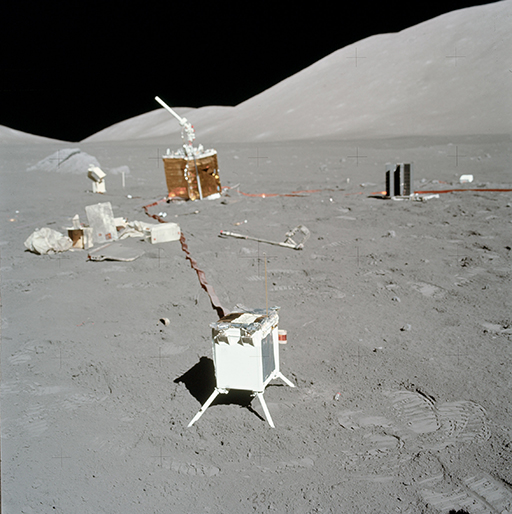2.4 Experiments on the Moon
The astronauts didn’t just drop feathers and hammers; they also performed some more complex experiments. You have already learnt about the laser ranging reflectors. Some of the others are shown here.
Figure 8 is an active seismic experiment.
- Why? To determine the internal structure of the Moon.
- How? It was composed of three geophones that could detect movement from controlled explosions. The movement gave information about the Moon’s internal structure.
Figure 9 is a solar wind spectrometer experiment.
- Why? To study solar winds and their effects on the Moon’s environment.
- How? Solar wind is composed of electrically charged particles from the Sun. A sheet of aluminium or platinum foil was placed on the Moon for a number of hours to collect the solar wind particles. The foil was brought back to Earth for analysis.
Figure 10 is a lunar surface gravimeter.
- Why? To measure the gravity on the surface of the Moon precisely.
- How? A sensitive spring balance. Reliable data could not be collected because of a design error.
Figure 11 is a lunar ejecta and meteorites experiment.
- Why? To study dust ejected from the surface due to meteorite impacts and to study micrometeorites.
- How? Three sensors detected the movement of small particles from the east, from the west and from above. Large numbers of particles were seen each lunar morning, but the experiment would overheat a few hours after each lunar sunrise.
Figure 12 is a cold cathode ion gauge.
- Why? To measure the tiny pressure of the Moon’s atmosphere.
- How? Typically used for very low-pressure measurements, a cold cathode ion gauge traps electrons which are used to ionise any atoms or molecules present. These ions travel to the cathode and create a current.
See also: Apollo 16 third-stage crash site identified [Tip: hold Ctrl and click a link to open it in a new tab. (Hide tip)] . The crater made when the 3rd stage of the Apollo 16 rocket was deliberately crashed into the lunar surface at 2.6 km per second in 1972 has recently been found on high resolution images from orbit. The impact acted as a source of seismic waves to probe the Moon’s interior with the aid of seismometers placed on the surface by earlier Apollo missions.





